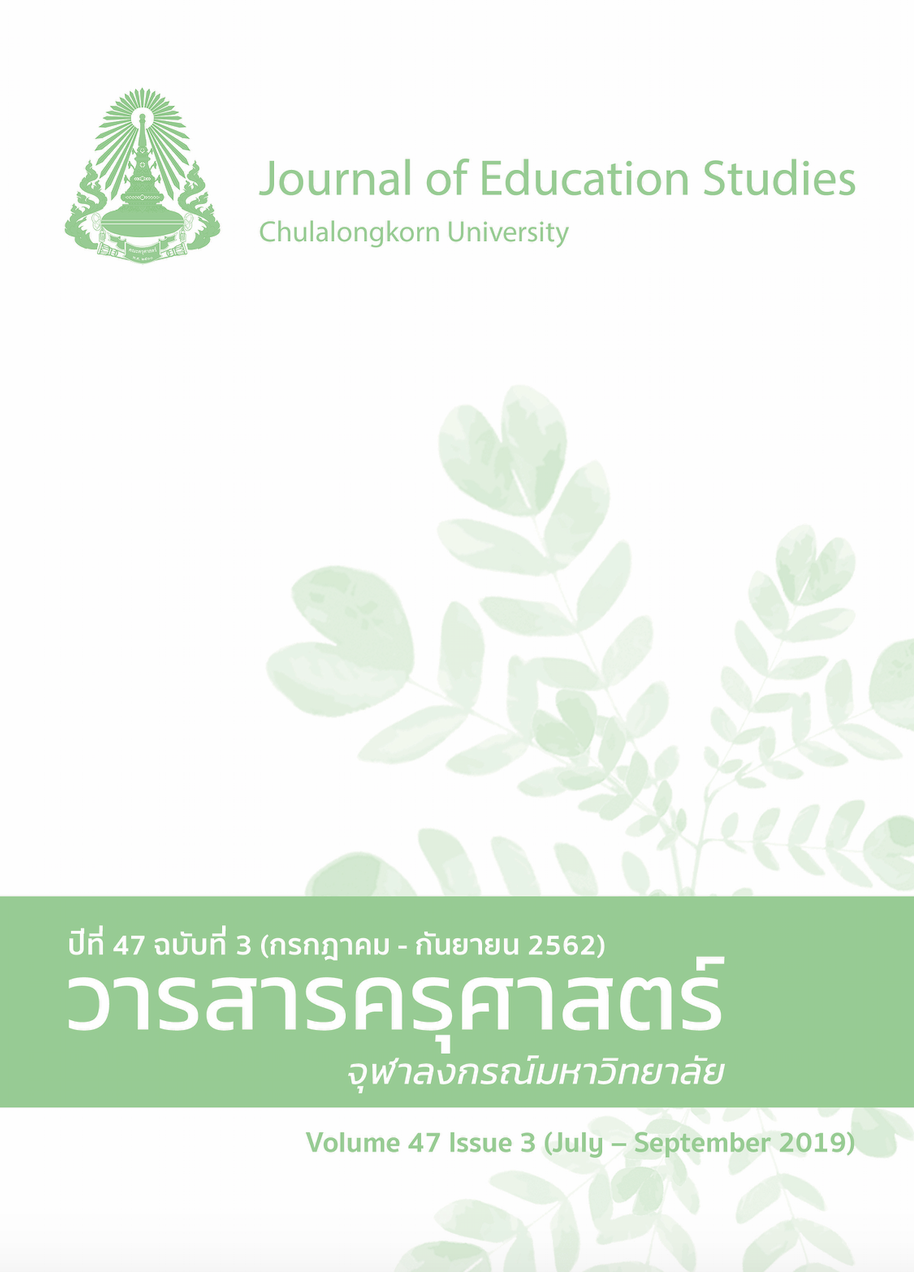CU Flipped Smart: Research-Based Innovation for Learning in the 21st Century
Keywords:
SMART TECHNOLOGY, FLIPPED LEARNING, 21ST CENTURY SKILLS, HIGHER EDUCATIONAbstract
This article aims to present CU Flipped Smart system or CUFS, a learning process innovation developed from the research titled Smart Technology for Flipped Classroom to Enhance 21st Century Skills in Life and Career Skills for Higher Education Learners. CUFS was the integration between smart technology and flipped Learning concepts to create learning with smart technology for flipped classroom to enhance 21st century skills in life and career skills of leaners. The article proposes conceptual framework and theories which are the foundation for developing this innovation including cognitive constructivism, social constructivism, and self-regulated learning. Then, the article presents the highlight of the innovation that focuses on responsive design to enable the system to be used with different mobile devices according to Bring Your Own Devices (BYOD) concept. Gamification concept was also used to enhance the system to challenge digital learners. The last part of this article shows the conclusion of the research that developed the innovation. It was designed and developed based on R&D research process to be a guideline for applying in the actual context effectively and create the utmost effectiveness for higher education learners.
References
ภาษาไทย
กระทรวงเทคโนโลยีสารสนเทศและการสื่อสาร. (2557). (ร่าง) แผนแม่บทเทคโนโลยีสารสนเทศและการสื่อสาร (ฉบับที่ 3) ของประเทศไทย พ.ศ.2557-2561. สืบค้นจากhttps://itc.ddc.moph.go.th/file/
it_plan_58.pdf
วิจารณ์ พานิช. (2556). ครูเพื่อศิษย์สร้างห้องเรียนกลับทาง. กรุงเทพฯ: เอสอาร์พริ้นติ้งแมสโปรดักส์.
จินตวีร์ คล้ายสังข์ และ ประกอบ กรณีกิจ. (2558). รายงานความก้าวหน้าโครงการวิจัยและพัฒนาโปรแกรมเสริมสำหรับระบบจัดการเรียนรู้ที่เน้นผลลัพธ์การเรียนรู้ในสภาพแวดล้อมอีเลิร์นนิงแบบผสมผสานศาสตร์การสอนสำหรับผู้เรียนระดับอุดมศึกษา. ทุนสำนักงานคณะกรรมการการอุดมศึกษา 2558. กรุงเทพฯ: คณะกรรมการการอุดมศึกษา.
ภาษาอังกฤษ
Allison, M., & Kendrick, L. (2015). Toward education 3.0: Pedagogical affordances and implications of social software and the semantic web. New Directions for Teaching and Learning, 2015(144), 109-119.
Blair, E., Maharaj, C., & Primus, S. (2016). Performance and perception in the flipped classroom. Education and Information Technologies, 21(6), 1465-1482.
Broadbent, J., & Poon, W. L. (2015). Self-regulated learning strategies and academic achievement in online higher education learning environments: A systematic review. Internet and Higher Education, 27, 1-13.
Brolin, D. E. (1989). Life centered career education: A competency based approach (3rd ed.). Reston, VA: The Council for Exceptional Children.
Cobb Country School. (2007). Annual Report 2007 Cobb County School. Retrieved from https:// www.cobbk12.org/centraloffice/communications/annualreports/annualreport07/
curr_inst4.htm
Elsaadany, A., & Abbas, K. (2016, May-June). Development and implementation of E-learning system in smart educational environment. MIPRO, 1004-1009. Opatija, Croatia.
Enfield, J. (2013). Looking at the impact of the flipped classroom model of instruction on undergraduate multimedia students at CSUN. TechTrends, 57(6), 14-27.
Foradian Technologies. (2015). 10 Smart technology tools for teachers. Retrieved from www.fedena.com/ blog/2015/04/10-smart-technology-tools-for-teachers.html
Hamdan, N., McKnight, P., McKnight, K., & Arfstrom, K. (2013). A review of flipped learning. Retrieved from https:// flippedlearning.org/wp-content/uploads/2016/07/LitReview_
FlippedLearning.pdf
Huang, R., Hu, Y., Yang, J., & Xiao, G. (2012). The functions of smart classroom in smart learning age. Paper presented at the Proceedings of the 20th International Conference on Computers in Education, ICCE 2012, 413-417. Retrieved from www.scopus.com
Hung, H. T. (2016). Clickers in the flipped classroom: bring your own device (BYOD) to promote student learning. Interactive Learning Environments, 25(8), 983-995.
Jansen, K. (2015). Smart=technology+sustainability+new economics-smart circle. Retrieved from https://www.smart-circle.org/smart-city/smart-technology-sustainability-new-economics
Kapp, K. M. (2016). Gamification designs for instruction. In C. M. Reigeluth, B. J. Beatty, & R. D. Myers (Eds.), Instructional-Design Theories and Models (pp. 351-383). New York: Routledge.
Keats, D. W. & Schmidt, J. P. (2007). The genesis and emergence of Education 3.0 in higher education and its potential for Africa. First Monday, 12(3).
Khlaisang, J. (2018). CU flipped smart application: A learning tool for 21st century learners. Paper presented at the Proceedings-6th IEEE International Conference on Mobile Cloud Computing, Services, and Engineering, MobileCloud 2018, 2018-January 103-108. doi:10.1109/MobileCloud.2018.00023
Lee, H., & Doh, Y. Y. (2012). A study on the relationship between educational achievement and emotional engagement in a gameful interface for video lecture systems. Paper presented at the Proceedings-2012 International Symposium on Ubiquitous Virtual Reality, ISUVR 2012, 34-37.
Moravec, J. (2011). Perspectives on invisible learning. Education futurist at education futures. Retrieved from https://www2.educationfutures.com/blog/2011/04/invisible-learning-released
Muntean, V. D., & Andreica, A. (2011). Interactive learning systems through virtual reality. Quality - Access to Success, 12(SUPPL.2), 815-821.
Nouri, J. (2016). The flipped classroom: for active, effective and increased learning–especially for low achievers. International Journal of Educational Technology in Higher Education, 13(1), 33.
November, A. & Mull, B. (2012). Flipped learning: A response to five common criticisms. Retrieved from https://novemberlearning.com/resources/articles/flipped-learning-a-response-to-five-common-criticisms-article
Ogawa, N. & Shimizu, A. (2016). Innovative approaches toward smart education at National Institute of Technology, Gifu College, Smart Innovation, Systems and Technologies, 59, 29-38.
Partnership for 21st Century Skills. (2011). Framework definitions. Retrieved from www.p21.org/ storage/documents/P21-Framework -Definitions.pdf
Schoolwires, (2013). The flipped classroom: A new way to look at schools. Retrieved from https://www.schoolwires,com/cons/lip3/flipped_classroom_0612.pdf
SMART Technologies Company. (2016). Inspiring innovation. Retrieved from https://www.smarttech.com/About
Vygotsky, L. S. (1980). Mind in society: The development of higher psychological processes. London: Harvard university press.
Wadsworth, S. J., Corley, R. P., & DeFries, J. C. (2014). Cognitive abilities in childhood and adolescence. Behavior genetics of cognition across the lifespan, 3-40.



